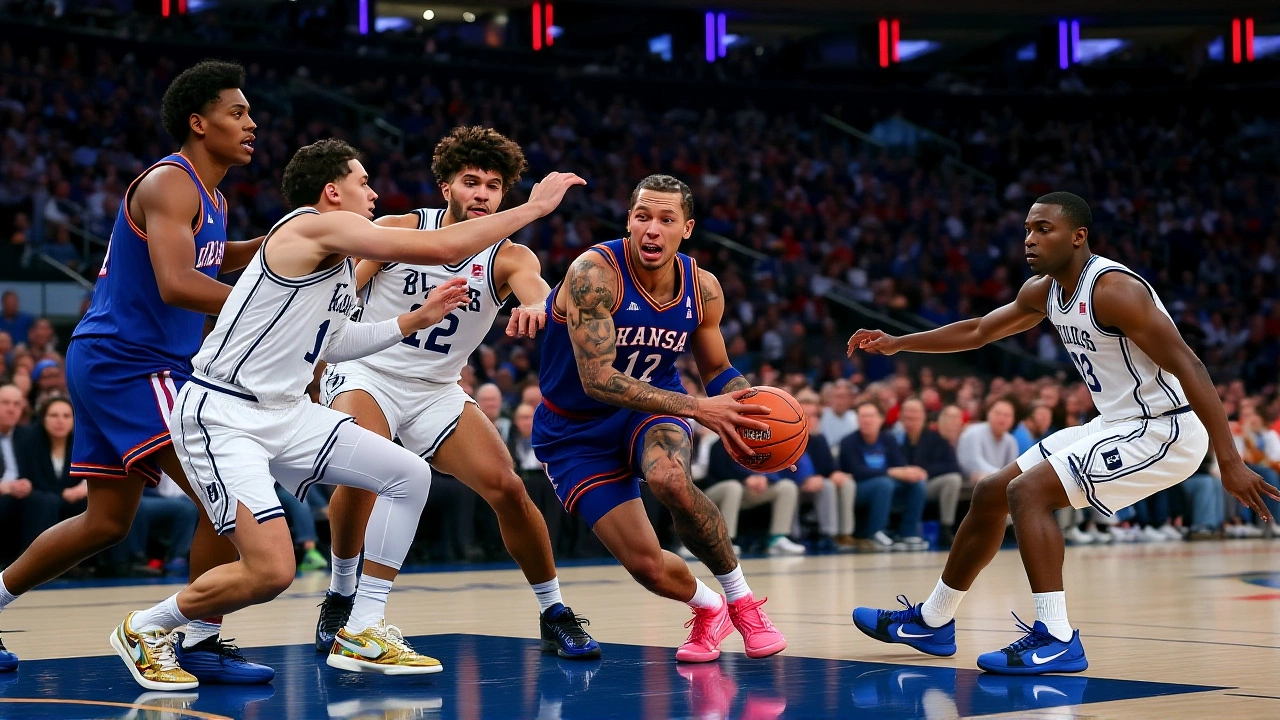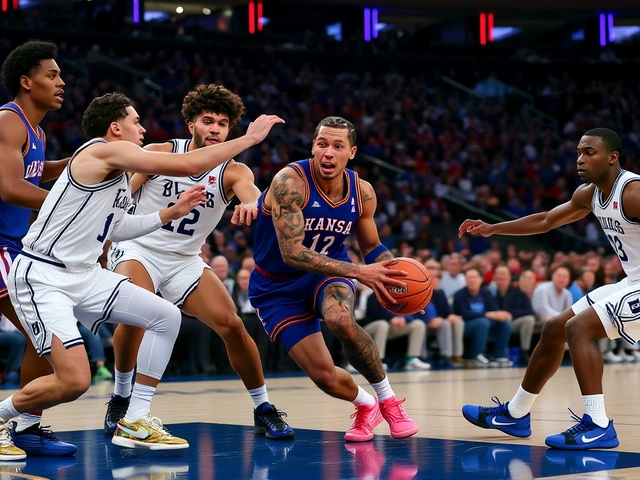
The Duke Blue Devils didn’t just win—they announced themselves. On Tuesday, November 18, 2025, at Madison Square Garden, the No. 5 Duke Blue Devils outlasted the No. 24 Kansas Jayhawks 78-66 in the State Farm Champions ClassicNew York City, turning a high-stakes showdown into a statement victory. It wasn’t pretty, but it was effective. And it was exactly what a program rebuilding under new leadership needed.
Boozer Steps Up When It Matters
For all the hype around Duke’s freshman guards, it was junior forward Cameron Boozer who anchored the win. He finished with 18 points, 10 rebounds, and five assists—his second double-double in three games—and played like a man who knew the spotlight was on him. His presence inside disrupted Kansas’s rhythm, especially in the second half, when the Jayhawks desperately tried to claw back. Boozer didn’t dominate the stat sheet with flash, but he made every possession count. His five assists? Those weren’t easy passes. They were backdoor cuts, skip passes over double teams, and timely outlets that turned defense into offense.
And then there was Isaiah Evans. The sophomore guard dropped 16 points, including a dagger three with just two seconds left on the shot clock late in the second half. Fans on the Duke Basketball Report forum called it “the shot of the game.” But the real play? “Boozer to Evans full court,” one user wrote. That sequence—starting with a steal, a sprint, and a perfect skip pass—was Duke basketball at its most efficient. It wasn’t just scoring; it was psychology. Kansas had been holding their own. Then that play happened. And the energy shifted.
Defensive Adjustments Decide the Game
Kansas came in riding high. Two days earlier, Flory Bidunga had dropped 25 points on 10-of-11 shooting against Princeton. He was unstoppable. But Duke’s defense had a plan. They switched everything. They denied him the post. They forced him into contested jumpers. He finished with just 11 points on 4-of-12 shooting. The contrast was stark. One game, he looked like a future NBA lottery pick. The next, he looked like a player who’d been outsmarted.
Duke’s bench depth was the secret weapon. Coach Jon Scheyer went nine deep—something he’s been building since taking over for Mike Krzyzewski. Darren and Nik, two lesser-known rotation players, combined for 14 minutes in the second half and kept the tempo high. “They’re young again,” said Kansas coach Bill Self. “But I think they may execute their stuff better than last year.” He wasn’t wrong. Duke’s ball movement was crisp. Their rotations were sharp. And when Kansas tried to press, Duke didn’t panic. They just passed their way out of it.

A Rivalry Rekindled
Kansas had won five of the last six meetings against Duke, including the last two. The Jayhawks had the psychological edge. But this wasn’t about history. It was about now. Duke’s win snapped a two-game losing streak against Kansas and gave them their fifth straight victory to start the 2025-26 season. Meanwhile, Kansas dropped to 3-2, their second loss after a 78-74 heartbreaker to North Carolina on November 7.
What made this game feel different? The stakes. The stage. The Garden. This wasn’t a regular-season non-conference game. It was the Champions Classic—a tradition that pairs elite programs in neutral venues to ignite national interest. And Duke didn’t just show up. They owned it.
What’s Next for Both Programs?
Kansas now faces a brutal stretch: two more neutral-site games against ACC foes. First, Notre Dame on November 25, then Syracuse on November 29. Both are tough, physical teams. The Jayhawks can’t afford another slip-up if they want to stay in the Top 25 conversation.
Duke, meanwhile, returns home to Cameron Indoor Stadium to host St. John’s on November 25. The Red Storm are unranked, but they’re dangerous. If Duke wants to be taken seriously as a national title contender, they need to keep winning—especially at home. The Blue Devils’ free throw shooting (68.4%) remains a concern, but their depth, discipline, and defensive focus are improving fast.

The Bigger Picture
Jon Scheyer’s Duke isn’t trying to be Mike Krzyzewski’s Duke. It’s trying to be its own thing. Less reliance on one superstar, more on system, movement, and depth. And it’s working. This team doesn’t have a single player averaging over 18 points. But they have nine who can step up. That’s dangerous.
And for Kansas? Bill Self’s squad is still good—just not as good as they were last year. They’re still searching for consistency. Bidunga can’t carry them. They need more from their guards. And they need to stop letting elite teams dictate the pace.
For now, Duke has the upper hand. And for the first time in years, the Blue Devils aren’t just hoping to make noise. They’re making it.
Frequently Asked Questions
How did Cameron Boozer’s performance compare to his previous games this season?
Cameron Boozer’s 18-point, 10-rebound, 5-assist line against Kansas was his most complete game of the season. He’d posted 16 points and 8 rebounds against Indiana State and 14 points and 7 rebounds against Army, but this was his first double-double with five or more assists. His field goal percentage (81.3%) remained elite, and his defensive impact was noticeable—blocking two shots and altering several others. This performance signaled his emergence as Duke’s most reliable two-way player.
Why was Duke’s bench depth so crucial in this game?
With Duke playing its third game in 12 days and two of them on the road, fatigue was a real concern. Coach Scheyer rotated nine players, keeping starters under 30 minutes. Darren and Nik combined for 14 critical minutes in the second half, helping maintain defensive intensity and pace. Their energy allowed Duke to push the tempo when Kansas tried to slow things down. Without that depth, the Blue Devils likely would’ve faded down the stretch, as they did in their lone close game against Army.
What does this win mean for Duke’s national title chances?
This win gives Duke its first signature non-conference victory of the season and validates their early-season hype. Beating a ranked Kansas team on a neutral court—especially after losing to them in recent years—signals they’re a legitimate contender. Their depth, defensive versatility, and coaching stability under Scheyer make them a dark horse. But they still need to prove they can win on the road in the ACC and against elite frontcourts.
How did Kansas’s offensive struggles compare to their previous game against Princeton?
Just two days earlier, Flory Bidunga shot 10-of-11 against Princeton and scored 25 points. Against Duke, he managed just 11 points on 4-of-12 shooting, with only two free throws. Kansas as a team shot 38.7% from the field, down from 51.3% against Princeton. Duke’s defensive scheme—switching on screens, denying post entry, and collapsing on drives—completely neutralized their rhythm. The Jayhawks also turned the ball over 14 times, their highest total since their loss to North Carolina.
Why is the Champions Classic such a big deal in college basketball?
The Champions Classic, held annually at Madison Square Garden, pits four of college basketball’s most storied programs against each other in early-season matchups. It’s not just a game—it’s a cultural event. Past editions have featured Duke vs. Kentucky, Kansas vs. Michigan State, and other legendary rivalries. The event draws national TV audiences, recruits, and media attention, making it a barometer for early-season title contenders. Winning here doesn’t just boost rankings—it builds momentum.
What’s the significance of Duke’s 5-0 start this season?
Duke’s 5-0 start is their best since the 2021-22 season, when they opened 11-0. This year’s team is different—less reliant on one star, more balanced. They’ve beaten Army, Indiana State, and now Kansas—all by double digits. The win over Kansas is their first against a top-25 team since February 2024. If they can maintain this pace through ACC play, they could be a No. 1 seed in March. But the real test comes next week against St. John’s—and then the gauntlet of ACC road games.




